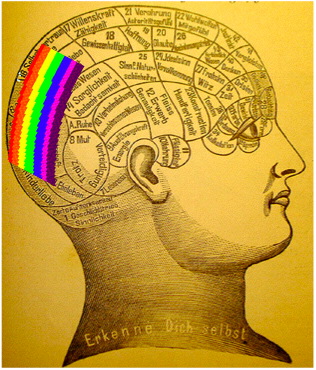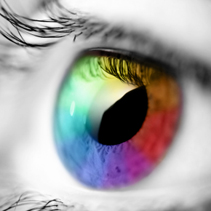
|
"Myth Busting" by The Human Tetrachromacy Research Collaborative: Toppling myths surrounding potential human tetrachromacy... |
|
 MYTH #1. The "100 Million Colors" idea:
MYTH #1. The "100 Million Colors" idea:
If you Google the term "tetrachromacy" the first few hits will bring up news articles reporting on the possible consequences of human tetrachromacy. If the popular media is your sole source of information, you'll have no difficulty finding several sources providing statements that assert that tetrachromats are "women who see 100 million colors".
The truth is, based on scientific experiments that have been done on human color vision, no one knows if human tetrachromats can see 100 million colors -- or even exactly how many colors a human tetrachromat can perceive. In fact, to my knowledge, no scientist has ever suggested the existence of such an empirical result (let alone demonstrated proof of "100 million colors" in a journal publication). The notion that 100-million colors is the consequence of expressing an extra photopigment class in one's retinas most likely comes from the over-simplification and over-generalization of a theoretical model. That is, it is based on an extrapolation of a theory involving the geometric expansion of visual capacities that are thought to arise with the addition of spectrally different photopigments when moving from dichromat observer types (a system involving 2-photopigment retinal processing) to trichromats (a 3-photopigment system) and on to tetrachromats (a 4-photopigment system). The geometric expansion theory is introduced briefly in the context of color vision by the excellent research team of Neitz, Carroll and Neitz (2001). Article found here. See Figure 3, and on p. 31-33 of the article entitled "Almost Reason Enough for Having Eyes." J. Neitz, J. Carroll, M. Neitz - Optics & Photonics News, 2001.
The first media mention of this magical "100 million colors" number seems to have occurred as a simplified interpretation of this geometric expansion theory found in a news article in 2006 appearing in the Pittzburg Post Gazette: Original news item found here.
This PPG news item featured an interview with Dr. Jay Neitz and the topic of his color vision genetics research. The PPG piece implies that Neitz said "100 million colors" in the same breath as human tetrachromacy, although what they write is not presented in quotations as if it was his very words. Instead it summarizes what he "said", and in that way connects tetrachromacy with the 100-million colors idea, and, if you read both the PPG piece and the Neitz, Carroll and Neitz (2001) article, you'll see there's a good chance that because of their fervor an oversimplification in quantifying ensued, and with the push to publication, some misinterpretation or loose quoting likely occurred as a result of such zeal. Just pointing out here the difficulties of blending science with popular media when constraints of news reporting are in operation.
Of course, given the power of the internet, the simple idea of "100 million colors" went viral as human tetrachromat news because, in part, it's an easy sound-bite that takes home a big message in real terms. In fact, there is no scientific basis for anyone to say that tetrachromats see 100 million colors -- I've not been able to find a scientific report that says anything even remotely like that. That number comes from theory - out of an arithmetic generalization of what might be possible if one were to build a tetrachromat robot with perfect processing and no signal information loss or compression. But, we all know theories are not always shown to be 100% accurate after actual testing, and, chances are, given what we know about how human processing channels combine information, the potential for human tetrachromats to differentiate on the order of "100 million colors" is probably not a realistic estimate, and is most likely a gross overestimation.
BOTTOM LINE: The "100 million colors" number comes from theory that assumes perfect neural processing, and human neural processing systems are notoriously imperfect. Also, there is the common-sense argument: Would it not be the case that if it were really 99 million more colors than normal, a human tetrachromat difference would have been absolutely trivial to show in an experiment? Well, as it turns out, it is not at all easy to show differences in color perception for potential human tetrachromats. So, why does the idea persist if it's not actually true? Perhaps, because it's easy to write about and digest, and people like to hear the "100 million color" idea because it's quantified, it's catchy, easy, uncomplicated. Generally, misconceptions of this sort are not unusual in public communications of results at the early discovery phases of phenomena. Scientists and media reporting will, given time, shake out the wheat from the chaff, good ideas will replace those that are less good. And hopefully as we learn more about potential human tetrachromacy there will be other interesting details to discuss, and explanations to give, and they will replace "100 million colors" idea for tetrachromacy with empirically demonstrated results and proven facts.
Return to The Human Tetrachromacy Research Collaborative page.
 MYTH #2. The idea that the potential for human tetrachromacy is "only possible in women":
MYTH #2. The idea that the potential for human tetrachromacy is "only possible in women":
Lorem ipsum dolor sit amet, consectetuer adipiscing elit. Fusce tempor arcu ac urna. Fusce congue eleifend mi. Pellentesque metus sem, elementum eu, rhoncus sed, gravida sit amet, nulla. Lorem ipsum dolor sit amet, consectetuer adipiscing elit.
found in a news article in 200? appearing in the Newsy News Gazette:
Original news item found here.
Lorem ipsum dolor sit amet, consectetuer adipiscing elit. Fusce tempor arcu ac urna. Fusce congue eleifend mi. Pellentesque metus sem, elementum eu, rhoncus sed, gravida sit amet, nulla. Lorem ipsum dolor sit amet, consectetuer adipiscing elit.
BOTTOM LINE: The proven facts.
Return to The Human Tetrachromacy Research Collaborative page.
 MYTH #3. The idea that the real-world objects affording a potential human tetrachromat the ability for tetrachromatic color perception are "natural" as opposed to "man-made" objects:
MYTH #3. The idea that the real-world objects affording a potential human tetrachromat the ability for tetrachromatic color perception are "natural" as opposed to "man-made" objects:
Lorem ipsum dolor sit amet, consectetuer adipiscing elit. Fusce tempor arcu ac urna. Fusce congue eleifend mi. Pellentesque metus sem, elementum eu, rhoncus sed, gravida sit amet, nulla. Lorem ipsum dolor sit amet, consectetuer adipiscing elit.
found in a news article in 200? appearing in the Newsy News Gazette:
Original news item found here.
Lorem ipsum dolor sit amet, consectetuer adipiscing elit. Fusce tempor arcu ac urna. Fusce congue eleifend mi. Pellentesque metus sem, elementum eu, rhoncus sed, gravida sit amet, nulla. Lorem ipsum dolor sit amet, consectetuer adipiscing elit.
BOTTOM LINE: The proven facts.
Return to The Human Tetrachromacy Research Collaborative page.
 MYTH #4. Human tetrachromats can perceive more color in industry-standard RGB film photography and images than do normal color-vision human trichromats:
MYTH #4. Human tetrachromats can perceive more color in industry-standard RGB film photography and images than do normal color-vision human trichromats:
Lorem ipsum dolor sit amet, consectetuer adipiscing elit. Fusce tempor arcu ac urna. Fusce congue eleifend mi. Pellentesque metus sem, elementum eu, rhoncus sed, gravida sit amet, nulla. Lorem ipsum dolor sit amet, consectetuer adipiscing elit.
found in a news article in 200? appearing in the Newsy News Gazette:
Original news item found here.
Lorem ipsum dolor sit amet, consectetuer adipiscing elit. Fusce tempor arcu ac urna. Fusce congue eleifend mi. Pellentesque metus sem, elementum eu, rhoncus sed, gravida sit amet, nulla. Lorem ipsum dolor sit amet, consectetuer adipiscing elit.
BOTTOM LINE: The proven facts.
Return to The Human Tetrachromacy Research Collaborative page.
 MYTH #5. Video devices with three display primaries (e.g., RGB filters or phosphors) can never be used to demonstrate a potential human tetrachromacy difference in color perception:
MYTH #5. Video devices with three display primaries (e.g., RGB filters or phosphors) can never be used to demonstrate a potential human tetrachromacy difference in color perception:
Lorem ipsum dolor sit amet, consectetuer adipiscing elit. Fusce tempor arcu ac urna. Fusce congue eleifend mi. Pellentesque metus sem, elementum eu, rhoncus sed, gravida sit amet, nulla. Lorem ipsum dolor sit amet, consectetuer adipiscing elit.
found in a news article in 200? appearing in the Newsy News Gazette:
Original news item found here.
Lorem ipsum dolor sit amet, consectetuer adipiscing elit. Fusce tempor arcu ac urna. Fusce congue eleifend mi. Pellentesque metus sem, elementum eu, rhoncus sed, gravida sit amet, nulla. Lorem ipsum dolor sit amet, consectetuer adipiscing elit.
BOTTOM LINE: The proven facts.
Return to The Human Tetrachromacy Research Collaborative page.
 MYTH #n. ... More Myth Busting coming soon ...:
MYTH #n. ... More Myth Busting coming soon ...:
Lorem ipsum dolor sit amet, consectetuer adipiscing elit. Fusce tempor arcu ac urna. Fusce congue eleifend mi. Pellentesque metus sem, elementum eu, rhoncus sed, gravida sit amet, nulla. Lorem ipsum dolor sit amet, consectetuer adipiscing elit. Aenean condimentum, odio quis pharetra dignissim, diam nisl dignissim diam, eu interdum magna erat sit amet felis. Etiam non felis at urna tempus luctus. In ullamcorper nisl congue elit. In convallis nibh vitae justo. Quisque ac lectus vitae sem consequat sagittis. interdum magna erat sit amet felis. Etiam non felis at urna tempus luctus. In ullamcorper nisl congue elit. In convallis nibh vitae justo. Quisque ac lectus vitae sem consequat sagittis.
lorem ipsum dolor sit amet, consectetuer adipiscing elit. Fusce tempor arcu ac urna. Fusce congue eleifend mi. Pellentesque metus sem, elementum eu, rhoncus sed, gravida sit amet, nulla. Lorem ipsum dolor sit amet. Lorem ipsum dolor sit amet, consectetuer adipiscing elit. Fusce tempor arcu ac urn
a. Fusce congue eleifend mi.
Return to The Human Tetrachromacy Research Collaborative page.
PLEASE READ BEFORE PROCEEDING: The material provided on this page is strictly for personal use for instructional purposes. Materials obtained from this page may not be edited or redistributed. Citation for this material is: Jameson, K. A. (2014). "Myth Busting" by The Human Tetrachromacy Research Collaborative: Toppling myths surrounding potential human tetrachromacy. http://aris.ss.uci.edu/~kjameson/MythBusting.html. Creative Commons License 4.0. Kimberly A. Jameson. Sept. 15, 2014. U.C. Irvine.
Important Advisory: Information on this website is not an alternative to medical advice from your doctor or other professional healthcare provider. If you have any specific questions about any medical matter you should consult your doctor or other professional healthcare provider. If you think you may be suffering from any medical condition you should seek immediate medical attention. The opinions expressed on this website are the author's own and do not reflect the view of the University of California, or the National Science Foundation, or any funding agency.
 Click here to email The Human Tetrachromacy Research Collaborative
Click here to email The Human Tetrachromacy Research Collaborative

The contents of this website are subject to copyrights protections of Creative Commons International License 4.0 to Kimberly A. Jameson, September 18, 2014. UC Irvine.
Kimberly A. Jameson's Home Page
Created: 09/2014
